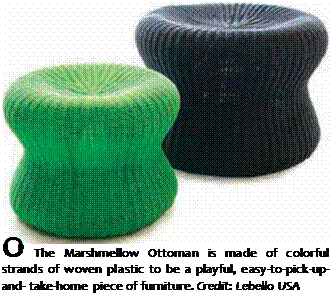 What he ended up with instead of handbags were crayon-colored, woven plastic ottomans, manufactured in Asia. Playfully dubbed Marshmellows, this product was less the result of a desire to make furniture, than the desire to make, well, something. “We’d tried designing products for export into the American market,” Dahmann says, “But we decided to make our own products. We wanted to have something that was instantly modern, but also classical. In terms of branding and naming, we wanted to have something that was very colorful and reflected the pop movement of the late ’60s and ’70s.”
What he ended up with instead of handbags were crayon-colored, woven plastic ottomans, manufactured in Asia. Playfully dubbed Marshmellows, this product was less the result of a desire to make furniture, than the desire to make, well, something. “We’d tried designing products for export into the American market,” Dahmann says, “But we decided to make our own products. We wanted to have something that was instantly modern, but also classical. In terms of branding and naming, we wanted to have something that was very colorful and reflected the pop movement of the late ’60s and ’70s.”
Dahmann found that furniture became a means for him to express his educational background and professional interest in both design and branding. “If you’re just an industrial designer making CAD drawings—although this works for many companies—you miss the whole package, the branding, the positioning, the price point, the product naming, the graphics,” Dahmann points out. “Having experience in all those areas, we create a product that has a brand within it. It allows us to control many aspects of our brand.” In addition to the actual product, Lebello is also designing labels, tags, and packaging. “We’re thinking of adding special carry bags for them,” he says. “Packaging becomes very critical for the product.”
In fact, carrying the product was a pivotal design concern. “My whole philosophy was to create a product that was easy to sell, easy to ship, easy to take home, to carry in your hands,” Dahmann notes. “I didn’t want people to have to order it, and then have a big box. I wanted it to be something that people could see in a window and put under their arm and take home.”
An ottoman became the perfect vehicle to unite all these disparate goals. “Ottomans are really popular,” Dahmann discovered. “People like little seats to put something on, but we didn’t want to make a boring, square ottoman. There are not a lot of choices out there. We wanted to give the consumer the option to choose a lot of colors. In interior design, people are trying to create ambience in their home, and we wanted to have a large selection of colors that would be fun and playful.”
Dahmann also wanted to manufacture the products in Indonesia. “Weaving is a traditional skill there, and I wanted to utilize the resources and skills they have. But it was difficult to find people who could weave in plastic, which is different than rattan. It requires more skill in terms of how you knot the plastic and it takes more strength because you have to pull harder on the plastic. It’s challenging,” Dahmann says, “but it’s a new trend that’s coming. People are turning more and more to plastic because it has a longer life expectancy and it can be used indoors or outdoors. It’s smoother. But because it’s a raw material that depends on the price of oil, it’s more expensive.”
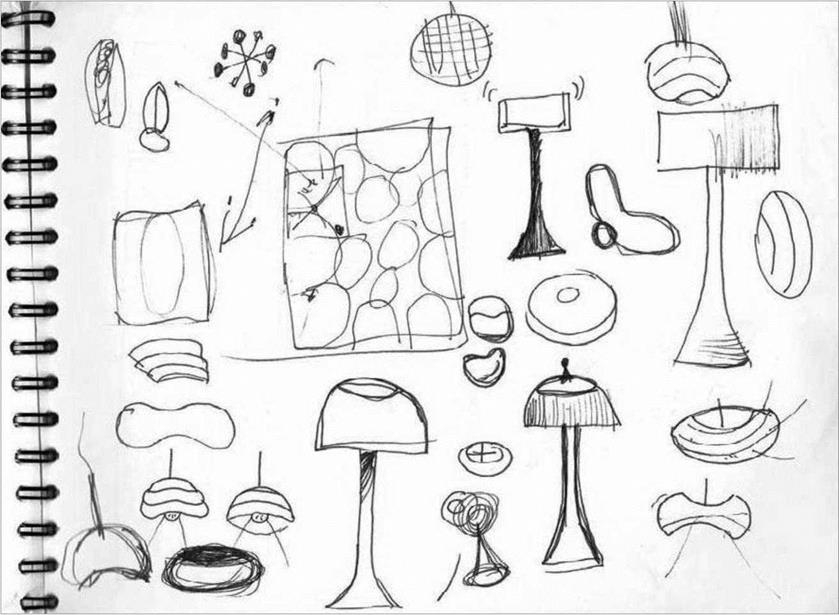
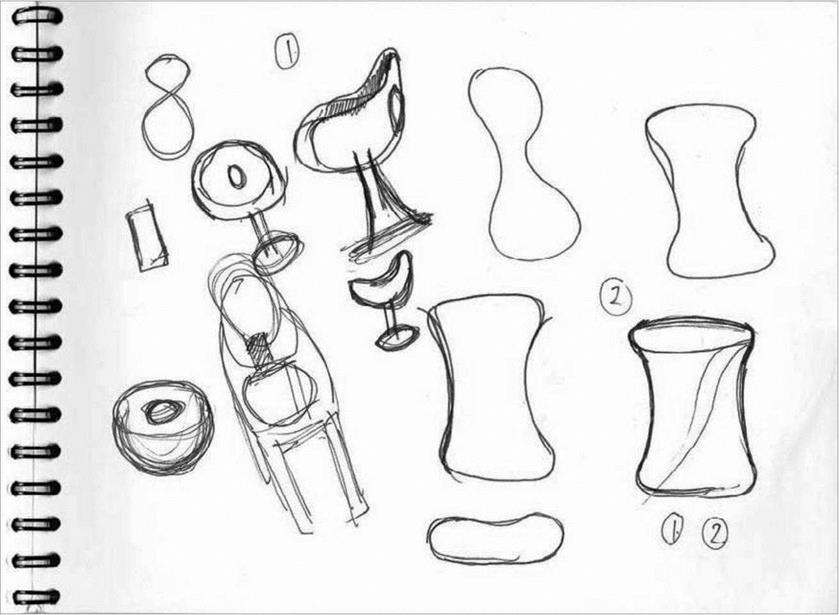
@ Top: Lebello was started to design, manufacture, market, and control the brand on a line of playful furniture that reflected the pop art sensibility. Credit: Lars Dahmann
@ Further into Lars Dahmann’s sketchbook, the form and sensibility of what would become the Marshmellow Ottoman begins to take shape.
Credit: Lars Dahmann
Using plastic was critical to giving the Marshmellow its signature attributes of bright colors, Pop sensibility, and indoor/outdoor versatility. So once they found a factory, Lebello spent a lot of time training the staff in quality and consistency. “It’s quite a lot of headaches,” Dahmann explains. “There’s a lot of training involved in helping them come up with better solutions. You need to be involved in every step, especially when you go into producing the product. The more control you have over it, the more you can control the quality and consistency of the end product and you have a better relationship with the factory.”
As part of his quality-control efforts, Dahmann specifies all the colors for the polycarbonate plastic strands using the Pantone Matching System, and insists on pigments from Germany and Japan, which he finds more durable and fade-resistant than the off-the-shelf varieties generally available. “Some very bright colors like orange or red, they will naturally fade no matter what,” he says. “Naturally the darker colors will have a lot longer life span. Black is the safest color against UV light. But the most critical thing is to not use cheap plastic,” Dahmann notes.
The Marshmellow comes in two sizes and two versions. “One is made with a bentwood frame and a solid core of rattan,” Dahmann explains. “The other one has an anodized steel frame, which is the all-weather outdoor model. The rattan is slightly cheaper, but in terms of durability, the steel frame will last longer.
The rattan frame is for mostly indoor use.” The steel framework is welded, while the rattan version is held together with stainless steel screws. He points out that in either incarnation, these pieces are time consuming to manufacture: “It takes a full day to make one.”
After working with different prototypes, trying to determine the most comfortable height, Lebello settled on two sizes. “The smaller one is much shorter,” Dahmann says. “It could be used for kids, or just to have your knees higher.” The Marshmellow is topped off with a cushion that is covered in a cotton case that can be unzipped and washed. “The cushion is offset in an accent color,” Dahmann points out, “to add more playfulness to the product.”
When Lebello began to introduce the Marshmellow and other products, Dahmann found their inherent whimsy elicited inconsistent responses. “When we started,” he recalls, “It was interesting to see what countries would be interested in our products. It was those that were more open—the Italians, the Spaniards, the Dutch—who were much more open to our products. The more conservative countries were not really into our products. We had a lot of American customers. Culture,” he notes, “has an impact.”
At the end of the day, for Dahmann, it’s all about the color. “When I see them together,” he says, “It’s the color that really excites people. It’s like fashion; we have a lot of colors so we can mix and match and create a really nice ambience.”
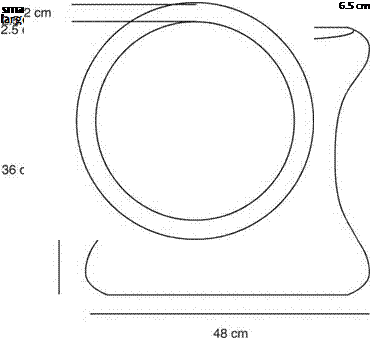 |
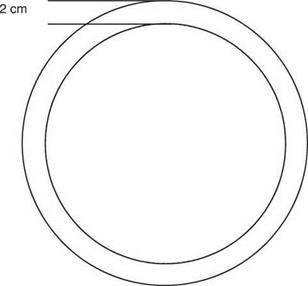 |
A technical drawing gives the exact measurements of the two versions of the Marshmellow; the smaller version is child-sized. Credit: Lebello USA
|
166 DESIGN SECRETS: FURNITURE |
|
^^Top left: The 2 mm and 3 mm (To") polycarbonate plastic strands used to weave the Marshmellow are custom-colored using the Pantone Matching System and dyes from Germany and Japan.
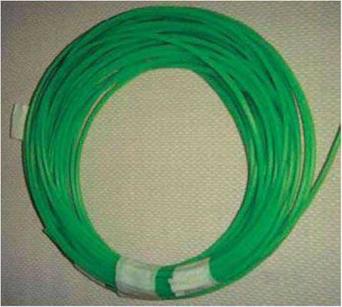 Credit: Lebello USA
Credit: Lebello USA
^v^Top middle: The Marshmellow is woven using traditional Indonesian craftsmanship. Credit: Lebello USA
^^Top right: The Marshmellow in rattan is woven on a bentwood frame and solid core of rattan. It is intended for indoor use. Credit: Lebello USA
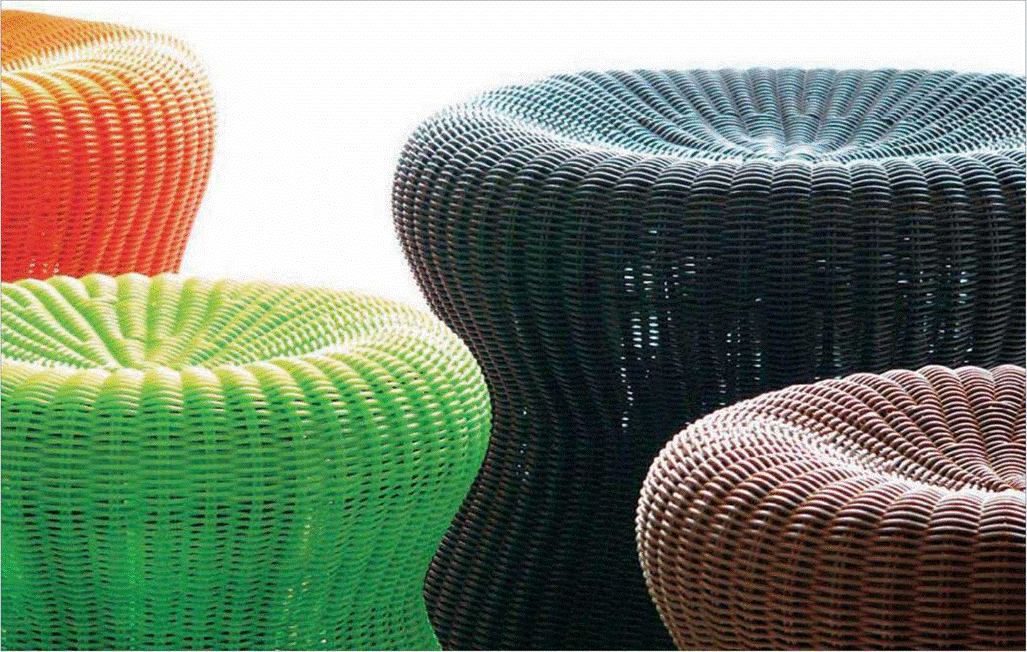 |
й Bottom: The Marshmellow in mix-and-match, collectible colors is made of plastic strands woven over a steel base and is intended for indoor or outdoor use. Credit: Lebello USA



